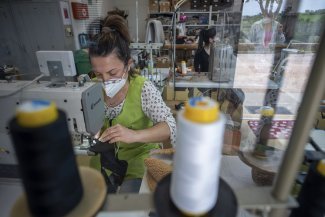The social stigma attached to harassment is so deeply ingrained in the world of work that victims often prefer to remain anonymous and most cases go unreported. Employers are reluctant to hire victims of harassment, which makes it almost impossible for them to re-enter the labour market.
“I don’t want to be a victim. I was a woman who used to carry a 9mm Parabellum in my pocket. I have never considered myself a weak person. But all those years of harassment took a toll on me, undermined my self-esteem,” 48-year-old harassment survivor, Ana (not her real name), tells Equal Times.
She has been waiting for more than a decade for compensation from the legal battle she started in 2009 against her harassers at the security firm she worked for in Bilbao. The tensions began when she refused to ignore irregularities committed by her superiors. What started as insults and humiliation gradually escalated into physical aggression in the form of pushing and shoving. “They didn’t succeed in shutting me up, and I pushed them back. But, little by little, they undermine you psychologically and make you feel like a weakling.
Her refusal to bow made matters worse. She stood her ground for over a year, but the harassment has left her with lifelong scars – post-traumatic stress disorder, anxiety attacks that led to an autoimmune disease, several operations and permanent disability – not to mention the tens of thousands of euros spent on taking her case to court and hundreds of hours of therapy.
They are the same symptoms as those left by rape or armed conflict, according to experts. Workplace harassment can lead to depression, anxiety, physical illness and, in the long term, permanent disability or even suicide.
The social stigma attached to harassment is so deeply ingrained in the world of work that victims often prefer to remain anonymous and most cases go unreported. Employers are reluctant to hire victims of harassment. They are sometimes considered to be weak or difficult workers, which makes it almost impossible for them to re-enter the labour market.
Convention 190 of the International Labour Organization (ILO) is the world’s first legally-binding international instrument against harassment and violence at work. It came into force in June 2021, but has only been ratified by ten countries so far, including two European countries, Italy and Greece. And of those ten, only Uruguay, Fiji and Namibia have implemented it.
In the case of Spain, lawyers, therapists and social workers specialised in workplace harassment maintain that it has become a growing problem in recent years. Whilst Spain is beginning to talk about mental health as a priority issue, harassment at work is still taboo – a situation similar to that in other European countries, but with subtle differences. And yet health and safety at work (including psychological health) could become a fundamental workers’ right by the middle of the year, a goal trade unions are fighting for within the ILO.
Resources are needed to know the scale of the problem
In the absence of standardised studies and statistics, the psychologists and psychiatrists in Spain’s primary care centres and hospitals consulted by Equal Times say that most of their patients come to them as a result of traumas and illnesses triggered by bullying and harassment at work, and that the number has increased. But there are no statistics on the matter.
Of Spain’s 14 million salaried workers, an estimated 3.5 per cent, or 490,000 employees, experience harassment at work. Of that total, less than two per cent of cases are prosecuted, and the percentage of legal battles won by the victims is disheartening. This data comes from the Basque Observatory on Harassment and Discrimination, based on the study of 1,100 rulings on workplace harassment in Spain between 2014 and 2019. It is the most recent study based on hard data, such as cases where legal proceedings are filed.
The data from these cases provides a profile of the harassers, the harassed and types of harassment. It shows that 75.9 per cent of harassers are male and 24.1 per cent are female. As for those harassed, 51.2 per cent are female and 48.8 per cent are male. Most women are bullied or harassed by women. The most common type of harassment is psychological (90 per cent), followed by discrimination based on ethnic origin, religion, age or sexual orientation (5.34 per cent), 2.11 per cent is gender-based (misogyny) and 2.39 per cent is sexual harassment. Eighty-eight per cent of harassment is vertical, from bosses to employees.
An earlier study published following the 2008 financial and economic crisis, the Cisneros Report, put the percentage of workers harassed in Spain at between 13 and 15 per cent of the active population, based on 1,250 interviews with workers in the Community of Madrid, with a guarantee of anonymity, and a broader definition of harassment. “We are talking about a huge unidentified source of suffering that affects millions of people. The victims are tagged as troublemakers, as lazy, etc.,” Iñaki Piñuel, psychologist and researcher at the University of Alcalá de Henares, who headed the report, tells Equal Times.
“I have been working on this issue for 20 years. In June 2001, I appeared before the Senate. And little progress has been made since then. The victims of workplace harassment are still treated as mentally ill, as victims of stress. Our well-meaning authorities still think the problem doesn’t exist,” adds Piñuel.
What is behind the lack of statistics? “There is no interest in it among the public administrations, which are responsible for allocating the resources needed to identify the exact scope of the harassment problem. If its real extent were known, a considerable amount of resources would have to be allocated to it. Whereas if it remains unknown, there is no need to do so,” explains the head of the Basque Observatory, lawyer Juan Ignacio Marcos.
Experts warn that the economic crisis triggered by the Covid-19 pandemic is likely to worsen the situation, as workplace bullying intensifies with rising unemployment and falling wages. The perpetrators know, after all, that the victims’ fear of losing their job is what keeps the victims defenceless.
According to an EU report, anxiety caused by occupational hazards, including bullying, is the second cause of work-related illness after musculoskeletal disorders (MSDs), and is likely to become the leading cause by 2022 or 2023. There is also, however, a lack of reliable statistics on workplace harassment at European level.
The tsunami in the making
The pandemic has triggered “a tsunami” in the impact and prevention of occupational risks, “the impact of which will be reflected in the 2024 survey,” explains Xabier Irastorza, project manager for the Prevention and Research Unit of the European Agency for Safety and Health at Work (EU-OSHA), whose European Survey of Enterprises on New and Emerging Risks (ESENER) report is the only EU-wide survey on occupational risk prevention. The findings of the survey are slanted, however, as participation is voluntary and therefore dominated by workplaces with the best risk prevention procedures, and it is the employer or manager who is interviewed in workplaces with less than 40 employees and the risk prevention technician in those with more than 40.
According to latest ESENER survey from 2019, based on interviews with more than 45,000 workplaces in the EU-28 (with the United Kingdom still included) plus Iceland, Macedonia, Norway, Serbia and Switzerland, Spain ranks among the European average. Irastorza, however, provides the keys to interpreting this statistic and discovering which countries have a higher rate of workplace harassment. “In the case of Spain, when we compare with other countries in terms of psychosocial risks, such as stress, violence at work and mobbing, we see that there was a higher percentage of workplaces with procedures to prevent harassment in 2019, compared with the previous report in 2014. The percentage has risen from 41 per cent to 56.3 per cent.” This does not indicate a higher rate of harassment but, rather, an increased awareness. The greater the awareness, the greater the prevention and, consequently, the lower the rate of harassment.
In this sense, it follows that the workplaces claiming not to have any problem with occupational hazards are the most worrying.
In Spain, a quarter of workplaces claim they do not suffer from any risk, which “is impossible, there is always risk,” says Irastorza, whilst in Denmark only nine per cent claim to be risk-free, on a par with other Nordic countries. This suggests a greater awareness of harassment, which they consider to be an “organisational risk” and are therefore better placed to prevent it.
The indicator that sheds the most light on workplace harassment is whether or not workers are involved in drawing up the company’s procedures to address workplace hazards. “Interestingly, more than a third of workplaces in the EU27_2020 (36 per cent) had none of these forms of employee representation,” says the report. The countries where workers are least involved (in drawing up occupational risk measures), and where the likelihood of bullying is subsequently higher, are Portugal (68 per cent), Latvia (63 per cent) and Poland (61 per cent).
“We were expecting the 49 per cent in Spain to be higher. The EU average is 57 per cent, so Spain isn’t too far behind. But in Spain and the EU as a whole, worker involvement in determining preventative measures (including against harassment) fell during the 2014 to 2019 period. It’s worrying that only half of Spanish companies should openly tell us that they involve their employees in the management of risks, including psychosocial risks,” explains Irastorza.
Other data indicating the effectiveness of psychosocial risk prevention is the election of the technician by employees, because where technicians are appointed by the management, they tend to favour the company rather than the employees. The countries where worker participation is highest, in this respect, are Finland and Italy (80 per cent), followed by Sweden (75 per cent). The rate in Spain is around 30 per cent, with Czech Republic, Switzerland, Germany, Holland and the United Kingdom trailing behind.
According to cautious estimates, workplace harassment costs up to four per cent of GDP. This amount is usually covered by social security rather than the employers, who do not pay and often appeal against unfavourable rulings. Ana won her case in the Spanish courts, albeit at a very high price. She has no regrets: “It was worth it. I have achieved one victory for now: the company has had to close down. As for me, I will die with my boots on and with the satisfaction of not having bowed.”













